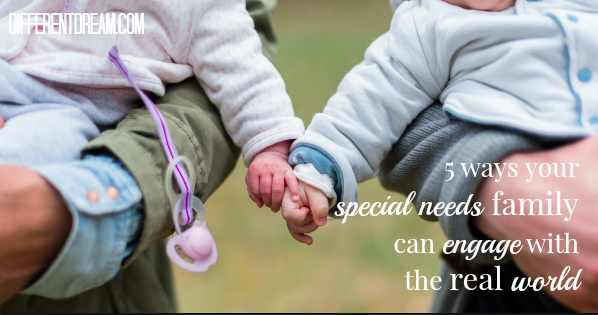5 Strategies for Staying Connected to the Real World

In the last four weeks, our family was hit by a series of health whammies. My husband’s hip replacement surgery was expected, but the others–Mom’s accelerated decline, painful back and neck issues for me, and the virus hitting my daughter and her kids–were not.
I was tempted to lay in bed and binge watch my favorite television show, Parks and Recreation, even after my back and neck recovered. Thanks to my parents, I knew the importance of keeping a family connected to the real world, even while battling health issues. Their involvement in the community, even after multiple sclerosis robbed Dad of his ability to walk when I was a child, is a powerful model of how to stay engaged when it’s easier to stay home and stare at screens all day. Maybe the strategies they taught me will help you and your child with special needs stay connected to the real world, too.
Strategy #1: Sit Outside
Engagement doesn’t get much easier than this. Sit on your porch, in the driveway (my dad’s preferred option), or on the front step. Wave to people walking or driving by. Invite neighbors to come over for a chat.
Strategy #2: Go Shopping
Since shopping has to be done, think of it as an opportunity to connect your child with the outside world. It takes extra work. I remember Mom putting Dad’s wheelchair in the trunk, hauling it out downtown, and putting it back in the trunk when the shopping was done. But I also remember how people said hello and stopped to chat. That wouldn’t have happened without the extra effort required.
Strategy #3: Go to the Library
Take your child to story hour and check out books afterwards. If time is of the essences for your child put items on hold a day or two beforehand so they can be quickly checked out. Either way, library trips show your child how to use books to explore the wider world. And it’s free. What could be better?
Strategy #4: Eat Out
Money was tight at our house, but Dad set aside money from his small civil service pension to eat out once a month. Mom didn’t have to cook, though she did have to haul Dad, his wheelchair, and 3 kids there and back. More important, our family was a visible reminder of Dad’s existence, and his being there prompted people to stop and visit.
Strategy #5: Attend Sports Events
Mom supported our family as an elementary school teacher. Though she must have been tired by the end of the week, but she frequently took us to home games. She drove the car to the edge of the football field and a steady stream of friends stopped to visit as the night progressed. She wheeled him into the gym during basketball season, and he positioned his chair beside the bleachers where the most people passed by. Whatever the score, every game was a win in Dad’s eyes as he connected with the real world.
Begin by putting one of these ways in place and adding others as circumstances allow. Staying connected with the real world requires more effort than clicking a remote or swiping a tablet. But the rewards are more satisfying and create a much richer environment for a child with special needs and the whole family. What more could a parent want?
Do you like what you see at DifferentDream.com? You can receive more great content by subscribing to the quarterly Different Dream newsletter and signing up for the daily RSS feed delivered to your email inbox. You can sign up for the first in the pop up box and the second at the bottom of this page.
By Jolene
Jolene Philo is a published author, speaker, wife, and mother of a son with special needs.
Subscribe for Updates from Jolene
Related Posts
The Lessons I Learned while Raising a Child with EA/TEF
Jolene Philo reflects on a lifetime of lessons learned while raising a child with EA/TEF and shares the insights she’s won.
Looking Back at Your Child’s EA/TEF Journey
Looking back at your child’s EA/TEF journey can give parents a new perspective about past events. Guest blogger Maggi Gale shares how her look back clearly showed her how God was with their family during their daughter’s very unusual first weeks of life in 2002. Three...
How Do I Let Go of My Adult EA/TEF Child?
Valeria Conshafter explores the question “How do I let go of my adult EA/TEF child?” for EA/TEF Awareness Month.






0 Comments